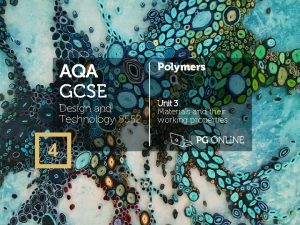AQA GCSE Design and Technology 8552 2 A






























- Slides: 30

AQA GCSE Design and Technology 8552 2 A The work of other designers Unit 6 Designing principles

Objectives • Know how to investigate, analyse and evaluate the work of others • Understand how investigating the work of other designers can inform designing

The work of others Unit 6 Designing principles The work of others • Researching the work of others is a key step in any design process • As well as inspiring new ideas this will help you understand the materials and processes necessary in your focus area • Investigate products both similar and dissimilar to your focus area to discern the design process • Who or what do you think is worth investigating as part of your research process?

The work of others Unit 6 Designing principles What to research? • All of the following contexts will provide a wealth of information and visual inspiration • Artists • Designers • Design companies • Design movements • Trends and fashions • The built environment • Abstract patterns, nature and science

The work of others Unit 6 Designing principles Product analysis • What might have been the original requirements of the humble egg-box design specification? • How does the design of the egg-box meet its requirements? • How can an investigation into the work of others be broken into different elements?

The work of others Unit 6 Designing principles Investigating the work of others • How can an investigation into the work of others be broken into different elements? • • • Materials Processes Aesthetics Design concepts Form and function Fitness for purpose Identify target market for product Manufacture / administration infrastructure Consistency with other products from the same designer How do established designs demonstrate what not to do?

The work of others Unit 6 Designing principles Analysing the work of others • Look at similar products from different designers • Compare and contrast different solutions to common problems • Separate the underlying design concepts from the methods of production • Select those elements that most closely match your own design objectives

The work of others Unit 6 Designing principles Analysis Complete Task 1 of Worksheet 2 A

The work of others Unit 6 Designing principles Evaluating the work of others • Evaluation should be as impartial and objective as possible • What common features of their designs made the designer, or design company so successful? • What else was being produced at the time, and how did those products compare? • How could some of their most successful features and ideas, influence your own designs?

The work of others Unit 6 Designing principles Evaluation Complete Task 2 of Worksheet 2 A

The work of others Unit 6 Designing principles Harry Beck 1902 -1974 Harry Beck is best known for redesigning the London Underground map • Previous maps were unsuccessful owing to the geography of London • Beck realised that people did not need to know the true distance between stations • His clear graphical layout became the recognised design template for transport maps around the World

The work of others Unit 6 Designing principles Harry Beck 1902 -1974 A trained electrical draughtsman, Harry Beck drew inspiration from the simplistic style used for electrical diagrams • His job was primarily to draw schematics for electrical systems of the London Underground

The work of others Unit 6 Designing principles Coco Chanel 1883 -1971 French fashion designer and founder of the Chanel brand • Her simplicity and style revolutionised women’s clothing in the 1920’s • She liberated women from the corset and introduced casual elegance • Her Little Black Dress remains the most iconic fashion item that transcends age • Chanel expanded her successful brand into perfume and cosmetics. By 1929, Chanel No. 5 was the best selling perfume in the World

The work of others Unit 6 Designing principles Alexander Mc. Queen 1969 -2010 The bad boy of British fashion, Mc. Queen delivered collections that pushed the boundaries of design • He completed an apprenticeship at a Savile Row tailors before finishing an MA in fashion • Fashion houses of Paris, including Givenchy, hired Mc. Queen which rocked the traditional world of fashion • His 2010 collection featured reptilian prints and alien inspired make-up • After winning a clutch of design awards he was awarded a CBE for services to fashion

The work of others Unit 6 Designing principles William Morris 1834 -1896 An outstanding figure of English textile design • Morris was associated with the Pre-Raphaelite Brotherhood and Arts and Craft Movement • Celebrated for his block printed fabric and textiles, he also produced elaborate embroidery and tapestries • Nature was his inspiration and he produced stylised evocations of plants and flowers • He revived traditional art processes that had been replaced by industrialisation

The work of others Unit 6 Designing principles Mary Quant 1934 British fashion designer who offered a refreshing alternative to fashion • Quant produced “relaxed clothes suited to the actions of normal life“ influenced by Mod style • She is often credited with creating the mini skirt. Whether or not she was the first, short skirts became synonymous with Quant style • Her daisy logo is recognised around the world

The work of others Unit 6 Designing principles Vivienne Westwood 1941 Famed for ripping up the fashion rule book with Malcolm Mc. Laren • The media dubbed their provocative style ‘Punk’ • In 1981, their first catwalk show created a template for the New Romantic look • Her designs often incorporate classic structured corsetry • Vivienne remains as challenging, innovative and anti-establishment as ever

The work of others Unit 6 Designing principles Marcel Breuer 1902 -1981 Influential Hungarian designer and architect • As a student of Bauhaus, Breuer produced the first tubular steel furniture • Breuer’s ground breaking design of the Wassily Chair remains just as fresh and modern today • Cesca, a chair made of a single curved piece of steel, became a famous and much copied cantilevered design • His striking architecture often showed a sculptural use of concrete

The work of others Unit 6 Designing principles Norman Foster 1935 British architect and founder of Foster + Partners • The partnership has created a wealth of outstanding buildings and structures around the World • Their designs are innovative, but practical and enhance our human experience with architecture • Creators of ambitious construction projects in challenging locations, they have realised iconic and landmark buildings

The work of others Unit 6 Designing principles Charles Rennie Mackintosh A Scottish designer, architect and artist 1868 -1928 • He was central to the success of Glasgow School of Art • His distinctive style of modernity with romanticism influenced building and furniture design of the early 20 th century • He utilised geometric lines and natural forms with Asian and Japanese influence

The work of others Unit 6 Designing principles Aldo Rossi 1931 -1997 An Italian architect and product designer • Highly regarded for his original and geometric forms, he became an outstanding figure of post modern architecture • In the 1980 s he worked with Alessi designing a series of iconic products including La Cupola coffee maker • He successfully expressed architectural and abstract form in his designs

The work of others Unit 6 Designing principles Gerrit Rietveld 1888 -1964 Dutch architect and furniture designer • In 1919 he joined forces with artists including Piet Mondrian and Theo van Doesburg as part of ‘De Stijl’ • ‘De Stijl’ used a combination of monochromatic and primary colour pallets displayed in geometric arrangements • His most notable architectural project was the Van Gogh Museum in Amsterdam, completed after his death

The work of others Unit 6 Designing principles Ettore Sottsass 1917 -2007 A leading figure of Italian design and the Memphis design movement • Working as a design consultant for Olivetti, he revolutionised typewriter design with the Valentine typewriter • He worked extensively in architecture completing private houses and public buildings • He is among the many designers who have created housewares for Alessi

The work of others Unit 6 Designing principles Philippe Starck 1949 French product designer and architect • A prolific designer of kitchen appliances, furniture and lighting, through to motorbikes and yachts • Stark’s flamboyant personality is often reflected in his products as he adds an element of humour to everyday items • Some say the Juicy Salif may be celebrated more for its form over function • Stark is rumoured to have said “It’s not meant to squeeze lemons, it is meant to start conversations”

The work of others Unit 6 Designing principles Raymond Templier 1891 -1968 An important figure in the world of Art Deco jewellery design • His work had a geometric style and was inspired by Cubism • He contrasted jewels with flat surfaces, matt with shiny materials • Templier jewellery is rare and highly sought after when ever items appear for public auction or sale

The work of others Unit 6 Designing principles Louis Comfort Tiffany 1848 -1933 A prolific American designer whose life long goal was ‘the pursuit of beauty’ • Rather than following his father in to the family business Tiffany & Co. , he channelled his creativity into art and then stained glass • His stained glass designs echoed his love of naturalistic forms, flowers and insects • Tiffany expanded his range into furniture, frescoes, lampshades and small artefacts • By his death, he was an internationally acclaimed leader of American design

The work of others Unit 6 Designing principles Sir Alec Issigonis 1906 -1988 Designer famed for the Morris Minor and Mini • His designs had more impact on Britain’s post war motor industry than any other designer • The Morris Minor was the first car to sell over a million units • His Mini designs broke the mould and revolutionised small car design • The iconic Mini continues to evolve today – a testament to its popularity

The work of others Unit 6 Designing principles Design movements • Styles and fashions change. Artists and designers take the lead in these changes and often form themselves into groups to promote their work • Recognised art and design movements include: • Arts and Crafts Movement 1853 – 1907: Morris • Art Nouveau 1880 – 1910: Tiffany • Art Deco 1908 – 1935: Mackintosh • De Stijl 1917 – 1931: Rietveld • Bauhaus 1919 – 1933: Breuer • Post-Modernism 1970 – 1990: Rossi • Memphis 1981 – 1988: Sottsass

The work of others Unit 6 Designing principles Styles and influences • Complete Task 3 of Worksheet 2 A

The work of others Unit 6 Designing principles Copyright © 2017 PG Online Limited The contents of this unit are protected by copyright. This unit and all the worksheets, Power. Point presentations, teaching guides and other associated files distributed with it are supplied to you by PG Online Limited under licence and may be used and copied by you only in accordance with the terms of the licence. Except as expressly permitted by the licence, no part of the materials distributed with this unit may be used, reproduced, stored in a retrieval system, or transmitted, in any form or by any means, electronic or otherwise, without the prior written permission of PG Online Limited. Licence agreement This is a legal agreement between you, the end user, and PG Online Limited. This unit and all the worksheets, Power. Point presentations, teaching guides and other associated files distributed with it is licensed, not sold, to you by PG Online Limited for use under the terms of the licence. The materials distributed with this unit may be freely copied and used by members of a single institution on a single site only. You are not permitted to share in any way any of the materials or part of the materials with any third party, including users on another site or individuals who are members of a separate institution. You acknowledge that the materials must remain with you, the licencing institution, and no part of the materials may be transferred to another institution. You also agree not to procure, authorise, encourage, facilitate or enable any third party to reproduce these materials in whole or in part without the prior permission of PG Online Limited.
 Gcse art aqa
Gcse art aqa Aqa design and technology past papers
Aqa design and technology past papers Aqa gcse pe 9 mark question examples
Aqa gcse pe 9 mark question examples Edexcel geography gcse checklist
Edexcel geography gcse checklist History paper 1
History paper 1 Chemistry vertical
Chemistry vertical Aqa rpe past papers
Aqa rpe past papers Aqa gcse maths revision checklist
Aqa gcse maths revision checklist Significant figures gcse
Significant figures gcse Edexcel history past papers
Edexcel history past papers Gcse angles questions
Gcse angles questions Aqa maths gcse revision guide
Aqa maths gcse revision guide How useful questions gcse history
How useful questions gcse history Kendal industrial park aqa
Kendal industrial park aqa Aqa gcse english literature specification
Aqa gcse english literature specification Sample design and technology gcse examination paper answers
Sample design and technology gcse examination paper answers Sample design and technology gcse examination paper answers
Sample design and technology gcse examination paper answers Sample design and technology gcse examination paper answers
Sample design and technology gcse examination paper answers World association of technology teachers
World association of technology teachers Gcse design and technology coursework examples 2019
Gcse design and technology coursework examples 2019 Design technology gcse coursework examples
Design technology gcse coursework examples Aqa a level art and design
Aqa a level art and design Art and design a level aqa
Art and design a level aqa Aqa product design
Aqa product design Aqa product design specification
Aqa product design specification Food technology gcse revision
Food technology gcse revision Edexcel art gcse past papers
Edexcel art gcse past papers Digital illuminate aqa food preparation and nutrition
Digital illuminate aqa food preparation and nutrition Task analysis food technology example
Task analysis food technology example Theme of ozymandias
Theme of ozymandias Forces in dt
Forces in dt




















































